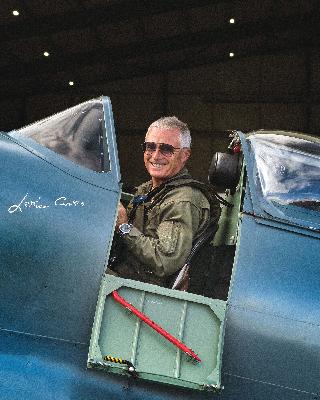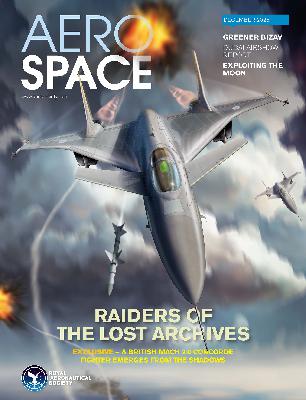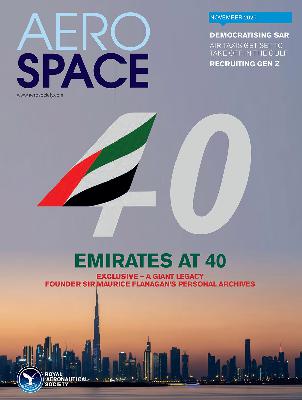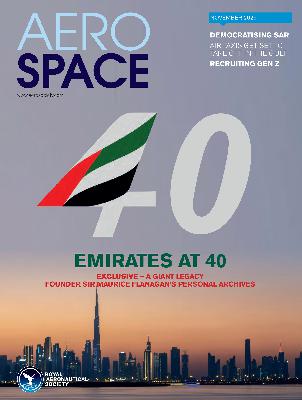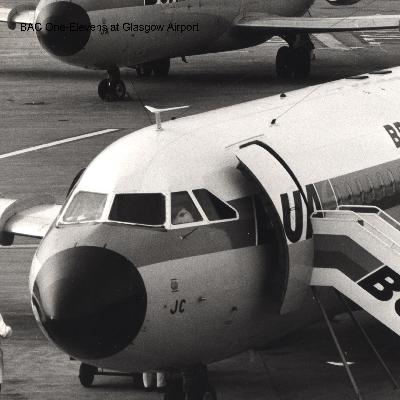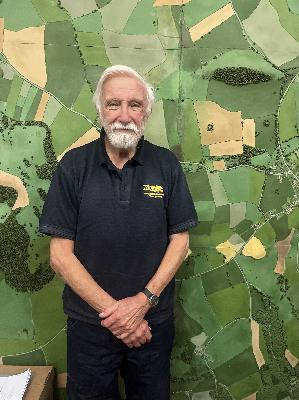Discover Royal Aeronautical Society Podcast
Royal Aeronautical Society Podcast

Royal Aeronautical Society Podcast
Author: AeroSociety Podcast
Subscribed: 232Played: 5,393Subscribe
Share
© All rights reserved
Description
The Royal Aeronautical Society is the world’s only professional body dedicated to the entire aerospace community. Established in 1866 to further the art, science and engineering of aeronautics, the Society has been at the forefront of developments in aerospace ever since.
130 Episodes
Reverse
John Romain MBE is a distinguished engineer, display pilot, and commercially successful aircraft restorer whose career has placed him at the forefront of historic aviation. He began his journey as a technician apprenticeship at Hawker Siddeley Dynamics and British Aerospace before helping restore Graham Warner’s Blenheim and founding the Aircraft Restoration Company, which now employs over seventy people working on the maintenance and restoration of classic aircraft.
As a pilot, John has flown an exceptional range of historic types, including the Lysander, Blenheim, B-17, B-25, Corsair, Me 109, Hurricane and numerous Spitfires.
Romain's renowned skills at display filming have taken him into major film productions, notably serving as Tom Cruise’s stunt pilot in Mission Impossible – The Final Reckoning and contributing to Dunkirk.
John’s life story reflects one of modest beginnings, great endeavour and a dedication to preserving aviation heritage.
John Romain MBE was interviewed by Keith Cameron in 2025 as part of the Royal Aeronautical Society/National Aerospace Library’s oral history project ‘If I only didn’t do it that way…….” Capturing history from the horse’s mouth to inspire today’s aeronautical professionals. The recording was edited by edited by Eur Ing Mike Stanberry FRAeS.
A transcript of the interview recording is available on the National Aerospace Library catalogue: https://www.podbean.com/eas/pb-5eha4-19f1da8
The photograph of John Romain shows him sat in the Spitfire XI that he restored and first flew again in 2018. The aircraft, nicknamed “Eleven” and “L”, was named in honour of pioneering aviator Lettice Curtis. In 1948, Curtis famously flew the aircraft when she set the British women’s record for the fastest time over a 100-kilometre closed-circuit course, achieving a speed of 313.208 mph.
The National Aerospace Library holds the certificate for Lettice Curtis’s record-breaking flight, along with a rich collection of papers and photographs documenting her life and work. These include material relating to her service with the Air Transport Auxiliary, her logbooks, and her post-war aviation career.
You can find out more here: https://www.aerosociety.com/news/eleanor-lettice-curtis-a-british-aviation-pioneer
In the latest podcast in series from the Royal Aeronautical Society's monthly AEROSPACE magazine, Editor in Chief Tim Robinson, Deputy Editor Stephen Bridgewater and Features Editor Bella Richards analyse recent aviation, aerospace and space news - and preview the latest (December 2025) edition of the magazine. Meanwhile, Seth Moffat, Chair of the RAeS Flight Operations Group talks to ex-Emirates Airlines Divisional Senior Vice President Flight Operations, Capt Alan Stealey about the global carriers' incredible history.
Concorde Test pilot Alan Smith’s path to BAC took him to flying Meteors and Venoms for the RAF and a colourful life in the pilot’s seat for smaller airlines in the late 1950s and into the 1960s. In this first interview, Alan Smith shares how he discovered his passion for aviation and recounts the early years of his RAF flying career, leading to his transition into civil airlines and ultimately becoming a Concorde test pilot. Through his stories, he brings to life the excitement of flying a wide variety of aircraft and the memorable pilots he met along the way.
Born in Newcastle upon Tyne in 1933, Alan Smith grew up beside the bustling Vickers-Armstrongs shipyard and started out as an apprentice plumber. But the skies were calling: on his 15th birthday in 1948, he joined the Air Cadets. A gliding course at RAF Ouston quickly earned him his A and B certificates, and he took part in cadet flights, including a memorable ride in a Lancaster at RAF Leuchars.
Soon after, he won a flying scholarship, clocked 30 hours on Tiger Moths, and earned his private pilot’s licence by early 1951. As the 100th recipient, he celebrated at the Royal Aero Club in London, where Lord Brabazon of Tara - holder of Aviator’s Certificate No. 1 - personally presented him with Certificate No. 27,000.
Just weeks later, Alan left plumbing and the Newcastle shipyards behind to join the RAF. After basic training at RAF Cranwell, he began flying at No. 6 Flying Training School, RAF Ternhill, where he flew solo after just 60 hours on the Percival Prentice. Alan Smith recalls meeting Wing Commander Flying Downey at the bar of the officers’ mess whilst celebrating the milestone of his first RAF solo flight.
He was then posted to RAF Middleton St George for advanced training on the Harvard, followed by a jet conversion course at 205 Advanced Flying School on the same Teesside airfield, flying the Gloster Meteor F.4 and T.7. He describes flying to Newcastle, diving over the city and being able to look down to see if his mother was in the back garden.
Alan’s next posting was to 228 Operational Conversion Unit at RAF Leeming for night-flying training, which included an exhilarating nocturnal flight in a de Havilland Mosquito, rendezvousing with a Meteor with no lights. He was then assigned to RAF Wahn near Cologne, West Germany, flying Meteor night fighters for two and a half years with the 2nd Tactical Air Force. He recalls incidents involving fellow pilots and one mission when he ran out of fuel and crash-landed after his hood became stuck.
Back in Britain, his hopes of becoming an RAF instructor at the Central Flying School were dashed when the Commandant disapproved of his lack of sporting experience. Instead, he joined 89 Squadron at RAF Stradishall, flying de Havilland Venom Mk 3 night fighters. When the unit was unexpectedly disbanded, he was pleasantly surprised to be appointed Officer-in-Charge of Stradishall’s Station Flight, overseeing the dispersal of 13 aircraft of five different types. During this period, he also completed an Instrument Flying Rating course on a Vickers Varsity at RAF Debden. However, Alan did not see himself as a Career Officer and left the RAF in April 1959 after seven years’ service.
Driven by his ambition to become an airline pilot, he next moved to London with his young family and studied for an Airline Transport Pilot’s Licence. He had to prove his skills all over again and passed with a twin-engine rating just eight months later.
Alan Smith talked with Julian Temple, Heritage Archivist for BAE Systems Heritage, on 1 March 2024. The recording was edited for podcast by Eur Ing Mike Stanberry FRAeS and is published by kind permission of BAE Systems for the Royal Aeronautical Society/National Aerospace Library’s oral history project ‘If I only didn’t do it that way…….” Capturing history from the horse’s mouth to inspire today’s aeronautical professionals. Further interviews with Alan Smith will be released in future podcasts.
A transcript of the interview recording is available on the National Aerospace Library catalogue: Alan Smith oral history interview | National Aerospace Library
Rival stealth fighters, eVTOLs in the air display and the 40th anniversary of the global airline giant that is Emirates, make this year’s Dubai Airshow the most exciting yet. AEROSPACE Editor in Chief TIM ROBINSON FRAeS and Deputy Editor STEPHEN BRIDGEWATER FRAeS preview the show
In the latest podcast in series from the Royal Aeronautical Society's monthly AEROSPACE magazine, Editor in Chief Tim Robinson, Deputy Editor Stephen Bridgewater and Features Editor Bella Richards analyse recent aviation, aerospace and space news - and preview the latest (November 2025) edition of the magazine. Plus in our regular Specialist Group Insight segment, the RAeS Flight Operations Group explore the art of fuel planning for airline pilots. Find out more at www.aerosociety.com
Philip Jarrett HonCRAeS is Britain’s foremost historian on the early days of aviation and spent his early career working on the production side for some of the most respected aviation titles such as the Aeroplane Monthly, Flight International, and the first days of the Royal Aeronautical Society’s AEROSPACE magazine.
Philip takes us through how his love of aviation was kindled and encouraged by many of the great aviation historians, such as Charles Gibbs-Smith and the charismatic figures he encountered at early Air-Britain and Cross and Cockade meetings, together with visits to the Aviation Bookshop and the Royal Aeronautical Society’s library.
Philip offers a fascinating insight into the people working behind the scenes to produce aviation magazines and paints a vivid picture of life working at the Royal Aeronautical Society during the 1960s.
Philip also sheds light on the ever-evolving world of magazine production from the 1960s to 1990s, explaining how the process of producing aviation magazines evolved over the period. In addition, he provides an insider’s perspective on the production of aviation books, notably his role in bringing together the six published volumes in the Putnam’s History of Aircraft series.
Philip concludes by discussing the trials and tribulations of writing history, including the challenges of deciphering the rapid evolution of aeroplanes before the First World War and how to winkle-out amazing material from libraries and archives across the world. He also gives us the low-down on the controversy over who was the first Briton to fly: A.V. Roe or Samuel Cody.
Philip Jarrett HonCRAeS was interviewed by Tony Pilmer FRAeS as part of the Royal Aeronautical Society/National Aerospace Library’s oral history project ‘If I only didn’t do it that way…….” Capturing history from the horse’s mouth' to inspire today’s aeronautical professionals'. The recording was edited by Eur Ing Mike Stanberry FRAeS.
A transcript of the interview recording is available on the National Aerospace Library catalogue
In the latest podcast in series from the Royal Aeronautical Society's monthly AEROSPACE magazine, Editor in Chief Tim Robinson, Deputy Editor Stephen Bridgewater and Features Editor Bella Richards analyse recent aviation, aerospace and space news - and preview the latest (October 2025) edition of the magazine. Plus we chat to Chris Hunter from the RAeS Flight Simulation Group to find out about their upcoming conference. Find out more at www.aerosociety.com
In the latest podcast in series from the Royal Aeronautical Society's monthly AEROSPACE magazine, Editor in Chief Tim Robinson, Deputy Editor Stephen Bridgewater and Features Editor Jack Richardson analyse recent aviation, aerospace and space news - and preview the latest (September 2025) edition of the magazine.
From working on the Miles Marathon and an early drone for ML Aviation to certifying the Boeing 747, Derek Ruben enjoyed a remarkable and distinguished career as an aeronautical engineer. Inspired as a schoolboy in the 1920s by the sight of airships over London and further encouraged in the 1930s by seeing Alan Cobham’s ‘Flying Circus’. Now 104 years old, Derek recalls starting aeronautical engineering degree in the first few months of the Second World War, and enjoying attending one of the earliest post-war courses at the newly established College of Aeronautics at Cranfield.
His career spanned an extraordinary breadth of experience. Recruited to the aerodynamics department at Miles Aircraft during 1942, amongst other projects, he contributed to the Miles Marathon, groundbreaking Miles M.52 project - which, had it not been cancelled, was poised to become the world’s first supersonic aircraft. He went on to address design challenges in a variety of projects with ML Aviation, including an early British UAV, and worked on the stability of the Beagle B.206. Joining the Aircraft Registration Board in the 1970s, he went onto play a pivotal role certifying the Boeing 747 and Concorde in the UK, including working with certification test pilot D. P. Davies.
Derek shares stories of the people he met during his studies and throughout his career, a journey that vividly reflects the extraordinary advances in aviation over a single lifetime and the enduring ingenuity of designers and engineers in overcoming new challenges.
Derek Ruben was interviewed by Sir George Cox CRAeS as part of the Royal Aeronautical Society/National Aerospace Library’s oral history project ‘If I only didn’t do it that way…….” Capturing history from the horse’s mouth to inspire today’s aeronautical professionals. The recording was edited by edited by Eur Ing Mike Stanberry FRAeS.
A transcript of the interview recording is available on the National Library's Catalogue
In the latest podcast in series from the Royal Aeronautical Society's monthly AEROSPACE magazine, Editor in Chief Tim Robinson, Deputy Editor Stephen Bridgewater and Features Editor Jack Richardson analyse recent aviation, aerospace and space news - and preview the latest (August 2025) edition of the magazine. In this episode, in the Specialist Group Insight segment, Flight Operations Group Chair talks to Cap Nav Kainth - co-founder and CEO of Athera on the topic on mental health. Find out more at www.aerosociety.com
From British Aircraft Corporation (BAC) and into BAE Systems (BAe), as one of BAe’s senior lawyers, Philip Riley FRAeS was well positioned to witness the people, the projects and the issues that shaped the British aircraft industry from the mid-1960s to the early years of the present century, living and breathing the roller coaster of amalgamations, nationalisations, mergers and privatisations that characterised the industry during those years.
Philip relished the opportunity to travel the world negotiating contracts and financial packages supporting the sale of aircraft such as the BAC One Eleven whilst working with some of the big names in aviation. During his early years at BAC, he decided to pursue a legal qualification - an ambitious move that ultimately led him to become a member of the company’s Legal Department as an in-house Solicitor. In that role he was involved in major contract negotiations, acquisitions and mergers including the privatisation of BAe, collaboration with Airbus partners and the amalgamation with GEC Marconi in 2000. In this conversation, Philip shares stories about the people he worked with and the challenges that the company faced.
After retiring from BAE Systems, Philip remained passionate about aviation. He became the secretary of the Farnborough Aerodrome Consultative Committee (formed by TAG, the operator of the airport) and subsequently became Chairman of that Committee.
His enthusiasm for aviation heritage led him to play a role in safeguarding heritage within BAe and ensuring that BAe’s rich heritage was preserved and protected for future generations.
As a founding member and the first Chairman of the Royal Aeronautical Society’s Farnborough Branch, Philip has made lasting contributions to the Society. He has also served as Treasurer and a member of the Society’s Council, and was involved in the re-location of the Society’s library to Farnborough (from its London HQ) and in the establishment of the National Aerospace Library at Farnborough. Philip reflects on the town’s rich contribution to the UK’s aviation heritage and its continued importance in the field.
Philip continues to be to be active in the community, currently supporting RAF Odiham in commemorating its centenary and participating in the aviation section of his local U3A branch.
Philip Riley FRAeS talked with Julian Temple, Heritage Archivist for BAE Systems Heritage, on 30 September 2024. The podcast was edited by Eur Ing Mike Stanberry FRAeS and is published by kind permission of BAE Systems for the Royal Aeronautical Society/National Aerospace Library’s oral history project ‘If I only didn’t do it that way…….” Capturing history from the horse’s mouth to inspire today’s aeronautical professionals.
A transcript of the interview recording is available on the National Library's Catalogue: https://raes.soutron.net/Portal/Default/en-GB/RecordView/Index/4182317
After leaving Ferrari, Arthur struck-out on his own as an engineering consultant, with projects ranging from trolley buses in post-Cold War Hungary to designing MRI scanner beds and defence work. One of clients, St Bernard’s Composites, liked working with him so much that they offered him the role of Technical Director with a seat on the board. Arthur recalls some of the interesting projects St. Bernard’s did with the likes of Rolls-Royce, Airbus, Martin-Baker and Imperial College.
Eur Ing Arthur Webb FRAeS was interviewed by Tony Pilmer FRAeS in 2024 and 2025 as part of the Royal Aeronautical Society/National Aerospace Library’s oral history project ‘If I only didn’t do it that way…….” Capturing history from the horse’s mouth' to inspire today’s aeronautical professionals'. The recording was edited by Eur Ing Mike Stanberry FRAeS.
When John Barnard was tempted to join Ferrari there was only one man that he wanted to cook-up his carbon fibres and do the stressing – Arthur Webb. They had a year to create the Guildford Technical Office (GTO) before the car needed to reach the grid. Of course, Arthur also had to go to Maranello and get the thumbs up from the great man, Enzo Ferrari.
Eur Ing Arthur Webb FRAeS was interviewed by Tony Pilmer FRAeS in 2025 as part of the Royal Aeronautical Society/National Aerospace Library’s oral history project ‘If I only didn’t do it that way…….” Capturing history from the horse’s mouth' to inspire today’s aeronautical professionals'. The recording was edited by Eur Ing Mike Stanberry FRAeS.
After not liking the way the nationalised BAC was going, Arthur Webb left Weybridge and headed to the small, secret and innovative special projects office of ML Aviation then onto Marconi Space. Here he tells us a little about working on drones, the JP233 anti-runway bomb for the Tornado, Skynet 4 and ESA’s Eureka project.
Eur Ing Arthur Webb FRAeS was interviewed by Tony Pilmer FRAeS in 2024 as part of the Royal Aeronautical Society/National Aerospace Library’s oral history project ‘If I only didn’t do it that way…….” Capturing history from the horse’s mouth' to inspire today’s aeronautical professionals'. The recording was edited by Eur Ing Mike Stanberry FRAeS.
In the latest podcast in series from the Royal Aeronautical Society's monthly AEROSPACE magazine, Editor in Chief Tim Robinson and Deputy Editor Stephen Bridgewater are joined by freelance author Charlotte Bailey to analyse recent aviation, aerospace and space news - and preview the latest (June 2025) edition of the magazine. In this episode, we also interview incoming RAeS President Alasdair Wood FRAeS. Find out more at www.aerosociety.com
When a young John Barnard was appointed as McLaren’s designer, he decided that carbon fibre was the future of Formula 1, but who should he ask to help him with his design? The answer was Arthur Webb of BAC. For a bit of fun in his own time, Arthur became McLaren’s unofficial carbon fibre consultant. Over the next few years, John and Arthur designed, tested and constructed the first carbon fibre shell of a Formula 1 car – a feet which not only made the car go faster, but saved drivers’ lives.
Arthur also describes other carbon fibre projects, such as how they worked to bring carbon fibre into rowing. We also explore his last years at BAC, including his work on Concorde before describing the depressing time that led up to the nationalisation of Britain’s aircraft industry.
Eur Ing Arthur Webb FRAeS was interviewed by Tony Pilmer FRAeS in 2024 as part of the Royal Aeronautical Society/National Aerospace Library’s oral history project ‘If I only didn’t do it that way…….” Capturing history from the horse’s mouth' to inspire today’s aeronautical professionals'. The recording was edited by Eur Ing Mike Stanberry FRAeS.
After marching up to the front gate of the BAC Weybridge factory and demanding to see the Chief Stressman, Arthur Webb was given the job of finding something useful to do with the new magic composite material discovered at the Royal Aircraft Establishment – carbon fibre.
In this part of his oral history interview, Arthur explores how he led a team to design the first certified civil aircraft component for an aeroplane, a pair of load carrying rudder panels on a VC10, with no data, no experience and no background. Arthur also retells the amazing story of he, thanks to good contacts and a lot of guile, persuaded Rolls-Royce that they too should use carbon fibre for structural applications.
Eur Ing Arthur Webb FRAeS was interviewed by Tony Pilmer FRAeS in 2024 as part of the Royal Aeronautical Society/National Aerospace Library’s oral history project ‘If I only didn’t do it that way…….” Capturing history from the horse’s mouth' to inspire today’s aeronautical professionals'. The recording was edited by Eur Ing Mike Stanberry FRAeS.
Stressing the 3-spar wing Armstrong-Whitworth Series 220 Argosy and the massive Lockheed C5 Galaxy wings was a fascinating way for an aero engineer in his twenties and early thirties to begin his career. As well as describing the design challenges, including the Argosy’s early use of bonded composites, Arthur shares what it was like during the brain drain: firstly working on the Galaxy for a UK contractor, before then moving to the USA with his young family and experiencing the racial tensions of 1960s Georgia.
Between working on the two freighters, he was selected as one of the few that moved from Coventry to Kingston, and tells us about his work keeping Second World War legacy aircraft in the air and his brush with one of the most dominant figures of twentieth century military aviation, Sir Sydney Camm HonFRAeS.
Arthur starts his oral history interview with telling us about watching British aircraft overhead from German occupied Jersey and how, after an encounter with Prof AD Young FRAeS, scraped through Queen Mary’s Aeronautical Engineering degree by the skin of his teeth.
Eur Ing Arthur Webb FRAeS was interviewed by Tony Pilmer FRAeS in 2024 as part of the Royal Aeronautical Society/National Aerospace Library’s oral history project ‘If I only didn’t do it that way…….” Capturing history from the horse’s mouth' to inspire today’s aeronautical professionals'. The recording was edited by Eur Ing Mike Stanberry FRAeS.
In this podcast series from the Royal Aeronautical Society's monthly AEROSPACE magazine, Editor in Chief Tim Robinson, Deputy Editor Stephen Bridgewater and Features Editor, Jack Richardson analyse recent aviation, aerospace and space news - and preview the latest (May 2025) edition of the magazine. In this episode, we also interview outgoing RAeS President David Chinn FRAeS. Find out more at www.aerosociety.com
From the sonic booms of Concorde to the cockpits of fighter aircraft, noise has always been a problem for aviators. Dr Graham Rood spent a fascinating career reducing the negative effects of sound, including groundbreaking research into helmet-based noise cancelling systems, and, in retirement, has joined colleagues at the Farnborough Air Sciences Trust (FAST) to safeguard the legacy generations of aeronautical researchers who worked in the birthplace of British aviation.
After receiving excellent all-round training as a Royal Aircraft Establishment (RAE) apprentice, Graham joined the Ministry of Defence’s Inspection Directorate, where he worked closely with aero engine companies. The role was both interesting and deeply satisfying, but his thirst for hands-on engineering led him to Christchurch, where he took on the role of Eng3 at the Royal Signals and Radar Establishment (SRDE), initially focusing on mobile power systems for the army.
His career progressed with a move to Boscombe Down where he worked at the Aeroplane and Armaments Experimental Establishment (A&AEE). During this period, Graham embarked on a part-time MSc at Southampton University’s Institute of Sound and Vibration. This research involved investigating the sonic booms of Concorde—a fascinating challenge that ultimately led him to pursue a PhD.
In 1974, he returned to Farnborough, where he became immersed in tackling cockpit noise, a problem that threatened to make communication impossible in low-flying jets. Determined to find solutions, Graham worked on developing advanced helmets and noise-cancellation systems. His role as a Flight Observer in fast jets allowed him to test and refine these innovations firsthand. His expertise and dedication saw him rise to become Head of the Acoustics and Vibration Section within the Man-Machine Integration Department.
Even after formally retiring, Graham’s passion for aviation and engineering remained undiminished. As one of QinetiQ’s Trusted Experts, he continued to lend his knowledge to the field. But it was his involvement with FAST that marked the beginning of a second career. Initially focused on preserving historic buildings, he soon took on the monumental task of saving vast archives of photographs, reports, and records that were at risk of being lost and forgotten. Thanks to Graham and his colleagues, future generations will be able to access and learn from the 100 years of pioneering technical and scientific work of the RAE.
Dr Graham Rood FRAeS talked with Roger Cansdale FRAeS on 28 January 2025 for the Royal Aeronautical Society/National Aerospace Library’s oral history project ‘If I only didn’t do it that way…….” Capturing history from the horse’s mouth to inspire today’s aeronautical professionals. … . The podcast was edited by Eur Ing Mike Stanberry FRAeS.
The transcript of the recording can be accessed on the National Aerospace Library's catalogue.


